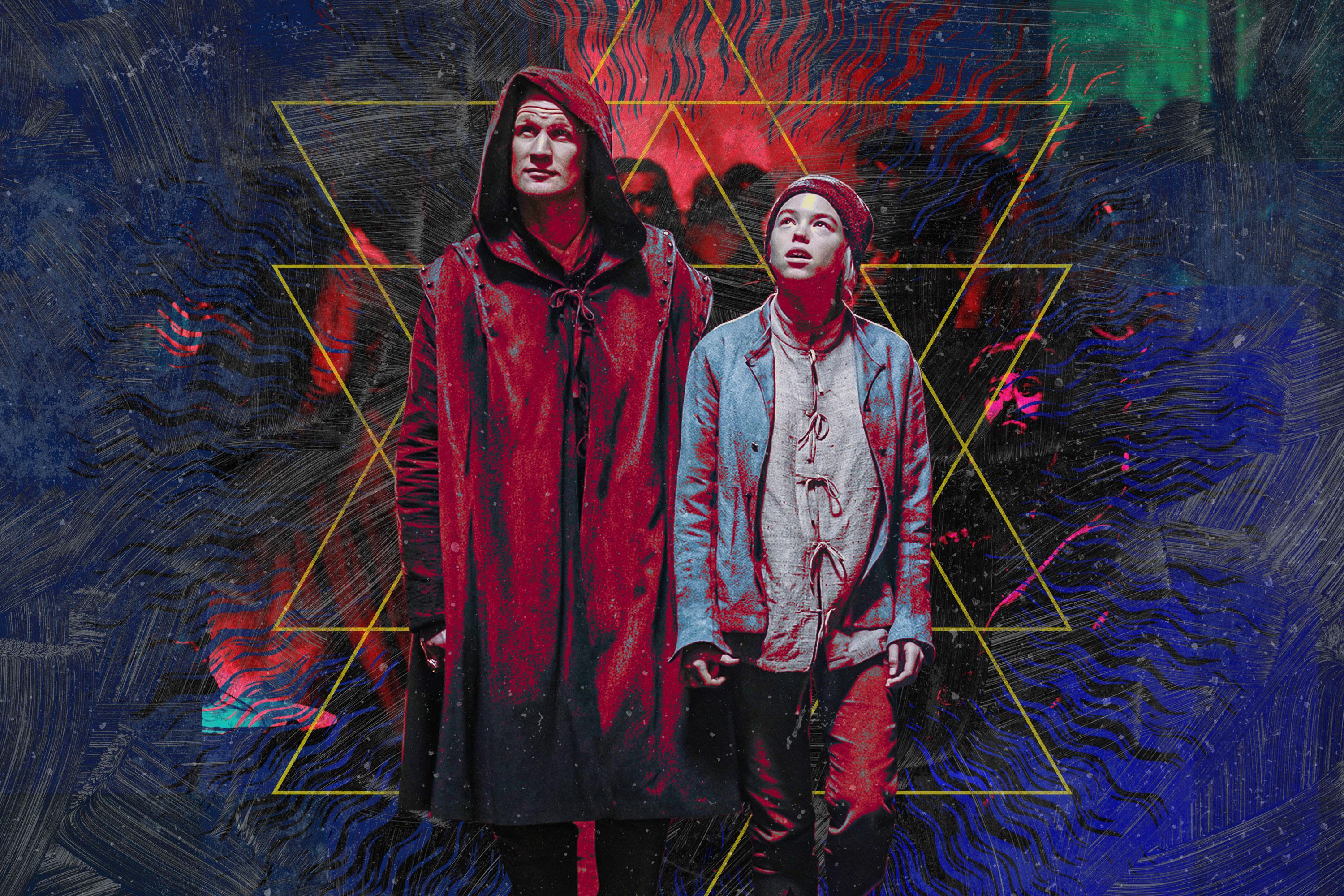‘House of the Dragon’ Needs to Get Out More
Like the book it’s based on, HBO’s series focuses on one family that’s largely confined to court. Rhaenyra’s foray in Episode 4 showed how much more alive Westeros feels when the characters escape their stuffy surroundings.
Editor’s note: On Saturday, Ringer senior staff writer Jonathan Tjarks passed away. You can find information about how to support Jonathan’s family here.
Midway through the fourth episode of House of the Dragon, Princess Rhaenyra returns to her chambers, expecting to spend another night in. Instead she discovers her ticket to a night on the town: a bag containing commonfolk camouflage and a piece of parchment, the latter of which reveals the exciting (if somewhat unsettling) presence of a secret passageway right by her bed. This X-marks-the-spot portal to the outside world—consistent with what George R.R. Martin’s Fire & Blood tells us of the “hidden doors and secret tunnels” installed by Maegor the Cruel—seems like a serious security risk. Yet to Rhaenyra, who smiles as she makes her escape, the drafty doorway offers a literal and figurative breather from her stuffy, circumscribed existence at court.
Rhaenyra’s rescuer—and soon-to-be tempter—is her uncle Daemon, who’s been slumming it in King’s Landing for much of his life. (Prior to his exile on Dragonstone, Daemon was known in King’s Landing as both “Prince of the City” and—more relevant to his trip with Rhaenyra—“Lord Flea Bottom.”) For Rhaenyra, such sowing of oats wasn’t an option, but she shares her uncle’s “restless and chaotic” streak. In an earlier conversation, the princess confided to Alicent that she didn’t intend to be married off and “imprisoned in a castle.” True to her word, she stages a prison break as soon as her spacious cell is unlocked.
When Rhaenyra and Daemon descend to street level, the screen teems with evidence of how much she’s missed. King’s Landing looks alive, its streets overflowing with fortune tellers and food vendors, troubadours and tightrope walkers, magicians and mummers. Sure, there are drunkards and pickpockets and there’s public indecency, too—but unlike the liquor and larceny at court, these bawdy excesses aren’t buried beneath a veneer of boring refinement. Among the masses, Rhaenyra can cosplay as a street urchin, feel “free of the burdens of [her] inheritance,” and—in the company of a certified orgy guy—witness sex acts she’s previously seen only on the Red Keep’s NC-17-rated tapestries. It’s not clear when last call in King’s Landing is, but the party’s still raging long after highborn lords and ladies’ bedtimes.
For Rhaenyra, this is an eye-opening excursion, one that makes cloistered castle life seem so suffocating that as soon as she gets back, she seduces Ser Criston Cole in an act of rebellion against the genteel life laid out for her. (A desire for spontaneous sex can conquer all, including her hot bodyguard’s vow of chastity and prophylactic full-body armor.) Her exposure to the seamier side of the city vividly conveys how hemmed in she is by the restrictions and expectations imposed on women in Westeros—particularly a woman whose maidenhood could be crucial to the future of the Targaryen regime.
But the sequence in Flea Bottom and the Street of Silk also highlights a limitation of House of the Dragon. Through its first four episodes, the Game of Thrones prequel has largely focused on one setting, one stratum of society, and even one family—an aspect of this series that sets it apart from its predecessor, whose extensive set of locations and characters really explored the studio space set up by Martin’s imagination. Rhaenyra’s foray from the castle is an overdue departure for Dragon—and a relief for any fans who’d had enough of watching characters cooped up in one place.
Granted, HBO’s Sunday centerpiece is only following Martin’s lead as laid out in his account of the leadup to the Dance of the Dragons. House of the Dragon is designed to do what it says on the tin: tell the story of the Targaryens, a ruling clan consumed by the pursuit and preservation of power. Power in Westeros revolves around the Iron Throne, and though dragons can cover vast distances, the throne doesn’t budge. House of the Dragon’s early episodes include detours to Dragonstone, the Stepstones, the Kingswood, and Storm’s End, but like its lead characters, its story must succumb to the gravity of the throne. Like an athlete who’s played in one place for too long, the prequel could use a change of scenery, but at this stage of the story, the series is squarely under Targaryen team control.
In Fire & Blood, narrator Archmaester Gyldayn observes, “So much of history tells of the deeds of kings and queens, high lords, noble knights, holy septons, and wise maesters that it is easy to forget the common folk who shared these times with the great and the mighty.” It’s also easy to forget them while watching this show. The smallfolk certainly seem beneath Rhaenyra’s notice: “Their wants are of no consequence,” she tells Daemon, a disturbing (if unsurprising) sentiment for a presumptive future ruler to express. Daemon responds, “They’re of great consequence if you expect to rule them one day.” But neither Fire & Blood nor House of the Dragon makes much time for the little guy.
Admittedly, Game of Thrones (and A Song of Ice and Fire) is also much more aligned with great man theory than history from below. Thrones never skimped on “great conversations in elegant rooms,” as Tyrion put it—and though Tyrion was a little guy in one respect, he was still a scion of Casterly Rock. To the extent that the smallfolk had a voice in the series, it was often expressed in someone else’s words. All roads eventually led to King’s Landing in that narrative, too.
Yet Thrones featured more cripples, bastards, and broken things than Dragon does, and many of its odd-couple pairings—Jaime (or Tyrion) and Bronn, Brienne and Pod, Bran and Hodor (or Osha), Davos and Shireen, Daenerys and Missandei, Jon and Ygritte, Tormund, or Jon’s Night’s Watch bros, Arya and … almost everyone Arya linked up with—supplied opportunities for discussions, conflicts, and alliances that crossed socioeconomic and cultural lines. Even the Targaryens on Game of Thrones had a broad assortment of associates. The Targaryens on House of the Dragon mostly talk to other Targaryens, and they usually discuss the same thing: How to stay at the top of the feudal food chain. “Is that all this show is about?” my wife wondered aloud after the umpteenth exchange concerning succession in “King of the Narrow Sea.” And, I mean … yes, sort of!
Dragon’s ultra-privileged core cast is much smaller—as Alicent laments, “I find I have few friends lately”—and, self-made woman Mysaria aside, much more homogenous, if not outright incestuous. (Speaking of which: Dragon’s incest is so icky it makes Jaime and Cersei’s forbidden love look wholesome.) As a consequence, it’s also significantly less spread out, which means that the show lacks a lot of the visual variety Thrones delivered as it flitted from the Free Cities to King’s Landing to Winterfell and the Wall. The two series’ respective title sequences sum up the difference: One took us on a tour of Westeros, while the other takes us on a tour of the Targaryens.
Which is why it was so refreshing for Rhaenyra to venture outside the Red Keep, gaze upon the whole of King’s Landing laid out below her, and then actually get dirty down there. Of course, she can’t completely escape the questions that weigh on her: Even the mummers of the city are obsessed with succession. (Understandably, given that the smallfolk’s safety and happiness hinges on whether the current king—or, hypothetically, queen—is one of the more despotic Targaryens or one of the “good” ones.) But both her face and the show light up during her brief, vibrant rumspringa, which would have made a decent backdoor pilot for the Flea Bottom spinoff that was promised (and then cruelly canceled).
While Rhaenyra gets in touch with her mischievous, sensual side, Alicent more or less lives the future that Rhaenyra hopes to avoid. Having squeezed out an heir, she struggles to soothe the bawling baby, then gives Viserys a sponge bath. Having his sores cleaned seems to turn the king on, because he soon summons the queen back to his room for some soulless, baby-making missionary. Surrounded by responsibilities and attendants, and at the king’s beck and call, Alicent lacks even the solitude Rhaenyra aspires to. From the gloomy building atop Aegon’s High Hill, she looks stoically out at lively King’s Landing like a caged bird that’s lost its song.
House of the Dragon’s great conversations still captivate viewers, but more field trips like this week’s—or journeys that take its characters even farther afield—would make it more dynamic. Like the time jumps that have fast-forwarded and sometimes set back the story so far, the series’ sameness in setting, character, and tone is presumably a bigger problem now than it will be later, when the dragons dance and spit fire for real, not only at funerals or in miniature models on the wrong side of the tracks of King’s Landing. But the prequel’s Targaryen tunnel vision isn’t going away: The prequel is, and will continue to be, about Westeros’s first family’s fight(s) for the throne. And as we know from Game of Thrones, Aegon’s chair isn’t going anywhere.
Near-perfect prequel Better Call Saul’s characters hardly ever left Albuquerque, but the rarely overlapping lawyer and cartel sides of the series kept each sphere feeling fresh. Perhaps that will be true of Dragon once its rival factions fully take shape or its comedic inclinations develop. (This week’s Blackwood-Bracken feud was funny, though the series is still missing a Mushroom type to take the piss out of the Targaryens.) And if Dragon doesn’t have as much story runway as its antecedent series, well, what of it? This series is slated to run for three or four seasons, not the eight Game of Thrones ran or the 10 or more Martin wanted it to run. It doesn’t have to be as huge as Thrones—in scope or in cultural cachet—to justify its time slot.
As it is, House of the Dragon is good. But to be great, it needs to get out more. That’s a tall order, given Fire & Blood’s dryness and story structure. But if Rhaenyra can slip out of a room whose one obvious exit is blocked by a guard, surely showrunner Ryan Condal and Co. can write themselves out of their Red Keep corner.

